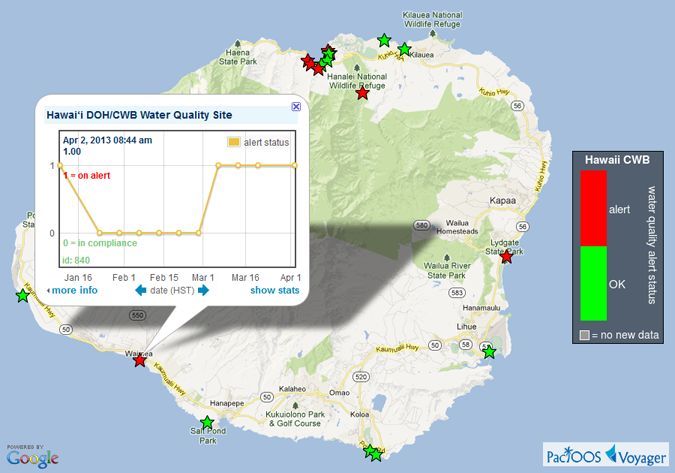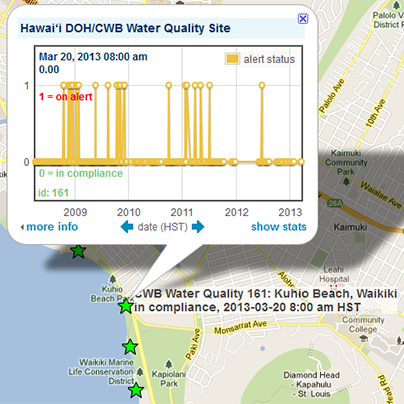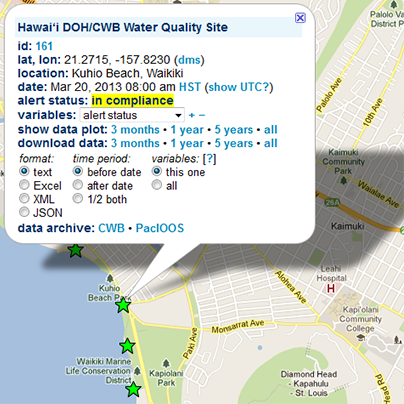Hawaiʻi Beach Water Quality Monitoring
Hawaiʻi Beach Water Quality Monitoring
Posted April 5, 2013Voyager’s “water quality” category now includes an overlay of coastal water quality measurements sampled by the Beach Monitoring Quality Assurance Program of the State of Hawaiʻi Department of Health (DOH) Clean Water Branch (CWB). Measurements of bacteria levels (Enterococcus and Clostridium perfingens) are used to assess water quality. These and other water measurements (water temperature, salinity, turbidity, pH, and dissolved oxygen) are collected periodically at several beaches throughout the state.
Voyager screenshot of the latest available water quality alert status across the island of Kauaʻi in the past 3 months:

Historically, this Voyager overlay had limited functionality: a pop-up window at each measurement site containing links to recent data hosted externally on the CWB website. Data are now brought directly into the pop-up windows, which contain interactive time-series plots and direct data download options for both recent and historic data of each available variable, including the water quality alert status. To enable this feature PacIOOS now archives and redistributes the CWB data, which we ingest from the U.S. Water Quality Portal and CWB websites. Because these sites do not archive the alert status, however, we compute this using the State’s criteria listed below. Public access is enabled through our ERDDAP data server, which provides flexible data queries and a large variety of download formats. Formal metadata here.
Water quality alert status at Waikīkī Kuhio Beach: (a.) time series plot over the past 5 years; (b.) “more info” screen provides various plotting and download options:
| a.) |  |
b.) |  |
CWB monitors Hawai’ʻi’s marine coastal waters using the U.S. Environmental Protection Agency (EPA) 1986 Ambient Water Quality Criteria for Bacteria. A beach is considered “on alert” for poor water quality if either: (a.) the latest water sample exceeds 104 CFU/100 mL of Enterococcus, or (b.) the geometric mean of the past 30 days of water samples exceeds 35 CFU/100 mL Enterococcus. These are the criteria that Voyager uses to indicate the water quality alert status. CWB also utilizes Clostridium perfringens as a secondary tracer to help distinguish between sewage and non-sewage sources of elevated Enterococcus levels. If Enterococcus concentrations remain elevated after resampling, a Clostridium perfringens concentration exceeding 50 CFU/100 mL requires a Waste Water Condition to be publicly posted. For these sorts of alerts, users are encouraged to check the CWB website for Current Warnings, Advisories and Postings.
Enterococcus bacteria has been correlated with the presence of human pathogens (disease-causing organisms) and therefore with human illnesses such as gastroenteritis, diarrhea, and various infections in epidemiological studies. Clostridium perfringens bacteria is a normal component of the human intestinal tract, and its presence in samples of sea water can be used as a tracer of sewage contamination. As such, concentrations of these bacteria are commonly measured in beach water quality monitoring programs. Please note that a limitation of all available and EPA-approved test methods is that the water sample must be incubated for about 24 hours. As a result, an alert status may or may not be reflective of actual water quality because it is based on tests performed one or more days ago.
For further information, please visit:







